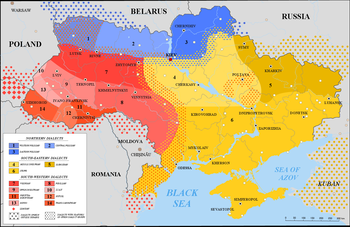| This article needs additional citations for verification. Please help improve this article by adding citations to reliable sources. Unsourced material may be challenged and removed. Find sources: "Lemko Region" – news · newspapers · books · scholar · JSTOR (March 2023) (Learn how and when to remove this message) |



The Lemko Region (Rusyn: Лемковина, romanized: Lemkovyna; Polish: Łemkowszczyzna; Ukrainian: Лемківщина, romanized: Lemkivshchyna) is an ethnographic area in southern Poland and Northern Eastern Slovakia that has traditionally been inhabited by the Lemko people. The land stretches approximately 140 km (87 mi) long and 25–50 km (16–31 mi) wide along the north side of the Carpathian Mountains, following the Polish-Slovak border from the Poprad River. In the East, the region is described as either terminating linguistically between the Wisłok and Osława Rivers, or ethnographically at the Sanok River (depending on the author), where it meets the Boyko region. Some even go so far as to consider it to extend south into the Prešov Region, Slovakia.
Previously a frontier area under the nominal control of Great Moravia, the Lemko Region became part of Poland in medieval Piast times. It was made part of the Austrian province of Galicia due to the First Partition of Poland in 1772. Parts were briefly independent under the Lemko-Rusyn Republic and Komancza Republic, and later annexed to Poland.
Most Lemkos in Poland were deported from their ancestral region as part of Operation Vistula in 1946, and only a small part of them remains there today, the rest being scattered across the Recovered Territories.
The landscape is typical of medium-height-mountain terrain, with ridges reaching 1,000 m (3,300 ft) and sometimes 1,300 m (4,300 ft). Only small parts of the southern Low Beskids and the northern San river region have a low-mountain landscape. Even so, the region still occupies some of the lowest elevations in the Carpathians: most of the Low Beskids, the western part of the Middle Beskids, and the eastern fringe of the Western Beskids. Conversely, it also includes much of the higher elevations of the Carpathians within modern-day Poland, which extend approximately to the Poprad River in the west (see: Ruś Szlachtowska). A series of mountain passes along the Torysa River and Poprad River (Tylych Pass 688 m (2,257 ft); Dukla Pass, 502 m (1,647 ft); and Łupków Pass, 657 m (2,156 ft)) facilitate communication between Galician and Transcarpathian Lemkos.
Publications
- "Łemkowie Grupa Etniczna czy Naród"?, , trans. Paul J. Best [pl]
- "The Lemkos of Poland" - Articles and Essays, editor Paul Best and Jarosław Moklak
- "The Lemko Region, 1939–1947 War, Occupation and Deportation" - Articles and Essays, editor Paul Best and Jarosław Moklak, ISBN 978-1938292033 (avail. from: Inter-Ed, Inc, New Haven, CT)
See also
References
- Magocsi, Paul Robert (2015). With Their Backs to the Mountains: A History of Carpathian Rus' and Carpatho-Rusyns. p. 4. ISBN 6155053391.
- Levinson, David (1994). Friedrich, Paul; Levinson, David (eds.). Encyclopedia of World Cultures: Russia and Eurasia, China. Encyclopedia of World Cultures. Vol. 6. Boston, Massachusetts: G. K. Hall. p. 69. ISBN 978-0-8161-1810-6.
External links
- SFULO - World federation of Ukrainian Lemko Unions
- LEMKY.COM - Lemkos Portal
- Magazine "Lemkivshchyna"
- lemko.org
| Rusyns topics | |||||||||
|---|---|---|---|---|---|---|---|---|---|
| Peoples | |||||||||
| Language | |||||||||
| Religion | |||||||||
| History |
| ||||||||
| Geography | |||||||||
| Organizations | |||||||||
| Culture | |||||||||
| Notable figures | |||||||||
49°34′00″N 20°59′00″E / 49.566667°N 20.983333°E / 49.566667; 20.983333
Categories: